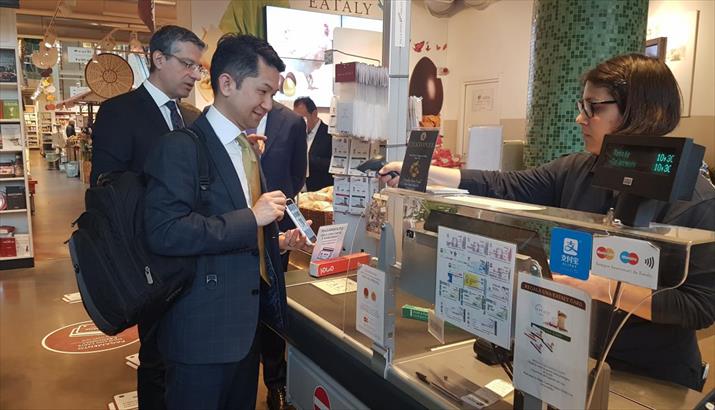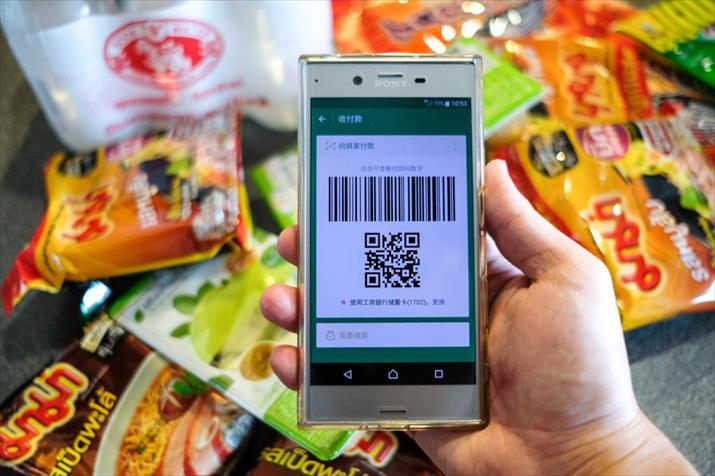|
||||||||||
| Home Nation World Business Opinion Lifestyle ChinAfrica Multimedia Columnists Documents Special Reports |
|
||||||||||
| Home Nation World Business Opinion Lifestyle ChinAfrica Multimedia Columnists Documents Special Reports |
| Business |
| Cash - What's That? |
| Chinese financial technology companies hope to enable consumer payments without cash or credit worldwide |
| By Bryan Michael Galvan | VOL.9 October 2017 ·2017-09-28 |

China's mobile payment providers are working to kickstart cashless societies around the world. Riding on the back of the growing numbers of Chinese tourists abroad, companies such as Ant Financial Services Group's Alipay and Tencent's WeChat Pay are developing new ways for consumers to spend their money while traveling without having to carry cash or credit.
In doing so, these enterprises seek to gain a foothold in countries that lack traditional credit card infrastructure, and grab hold of a nascent market that may fundamentally change how people interact with money.
In China, electronic wallets are ubiquitous, used for transactions both small and large. Last year, Chinese consumers made 35.3 trillion yuan ($5.2 trillion) worth of payments via mobile devices - around half the nation's GDP, according to Internet consulting firm Analysys.
By linking their bank accounts to mobile payment platforms, users can use the e-wallet services on their smartphones to pay rent and utility bills, hail taxis, manage their finances and do more. Due to the increasing use of these platforms, the amount of mobile payments in China is now 50 times greater than that in the United States, which amounted to $112 billion in 2016, according to data from American market research company Forrester Research.
The services provided by these companies have spread to small merchants and individuals who might not need to use cash or credit cards at all due to the convenience and ease of mobile payment options and the limited number of point of sale terminals in stores.

Eyeing outside markets
Chinese financial technology (fintech) companies aiming to expand their operations outside China by taking a cut from tourism spending have taken note. Chinese tourists spent $261 billion during their travels abroad last year, 12 percent more than the previous year, and the number of outbound travelers grew 6 percent to 135 million in 2016, according to figures from a United Nations World Tourism Organization (UNWTO) report.
"This growth consolidates China's position as the number one source market in the world since 2012, following a trend of double-digit growth in tourism expenditure every year since 2004," the UNWTO report said.
In January, Ant Financial and U.S. money transfer company MoneyGram announced a merger which would give the former access to 350,000 physical locations and 2.4 billion bank and mobile accounts under MoneyGram.
Nonetheless, there are numerous obstacles in the way of mass adoption of mobile payment, including fragmented reception among merchants - in part due to the growing variety of options available to consumers. Beijing-based QF Pay seeks to provide a one-stop mobile payment solution to merchants that would enable them to accept payment from customers that use a variety of mobile wallets and payment methods.
Patrick Ngan, President and Co-Founder of global mobile payment technology solutions provider QF Pay, told ChinAfrica that Southeast Asian countries all want to attract Chinese money. "Merchants all want Chinese tourism money. Those big conglomerates, those big shopping malls, they all want to have a big sign saying 'we welcome you' in Chinese because they know [the tourists] spend big."
Chinese mobile payment firms will also butt heads with conventional payment leaders such as Visa and MasterCard.
"If the sector doesn't have competition, then you'd be worried. There is going to be consolidation along the way, but mobile payment is only scratching the surface at the moment."
Dealing with differences
In China, mobile payment gained momentum following the use of social media apps like WeChat to send hongbao (gifts of red envelopes with money) during the Chinese Spring Festival. Sending hongbao was already a common practice, so once it became digitalized, the custom spread to sending e-gifts to friends and family in a complimentary fashion.
While that approach worked in China, the concept may not carry over to other countries unfamiliar with it. Chinese mobile payment companies will need to deal with different economic and cultural environments overseas. According to Ant Financial, the company is addressing the challenge by working together with local partners.
"Different markets have different environments and different growth paths for online and mobile payments. For instance, Alipay was created as an escrow service to facilitate online purchases back in 2004. In some of the markets where Ant Financial has local partners, e-commerce is not as prevalent as in China where mobile payment has started flourishing. The key for us is to rely on our local partners, who have a deep understanding of local environment and user behavior," said Ant Financial in the message released to ChinAfrica.
One of the reasons why mobile payment proliferated in China was due to the lack of credit card infrastructure in the past which allowed companies such as WeChat and Alipay to leapfrog technological hurdles. Fintech firms are growing in tandem with the number of rural consumers connecting to mobile Internet.
"A cashless lifestyle is not just about payment. It allows people to access basic financial services like saving, credit and financing in a low-cost and inclusive manner," said Ant Financial, adding that the company wants to build a system where people's purchases and transactions can contribute to their credit history. After accumulating payment history records, Ant Financial aims to provide micro loans for individuals as well as small businesses.
But while this strategy may work in countries such as China and India, fintech firms must tackle ingrained consumer habits in Western countries that are dominated by legacy payment methods. Mobile payment firms are addressing this challenge by tailoring products to merchants, analyzing big data from consumers and loyalty programs.
In Africa, while many countries still favor cash transactions, the continent is seen as a prime location for mobile money. The IMF reported last year that 11 percent of Africans and 60 percent of Kenyans have a mobile banking account. The global average figure is 2 percent. Kenyans have been using mobile-wallet payments for more than a decade with their app Mpesa (M for mobile and Pesa Swahili for money). The app is a leader in the developing world and allows its 20.7 million users in Kenya to deposit, withdraw, transfer money and pay for goods and services via their phones. Transactions totaled KES1 trillion ($10 billion) between July and September last year, according to the figure from the Kenyan Government.
Mpesa, which is also used in Tanzania, has been praised for giving millions access to the formal financial system and for also reducing crime in traditionally cash-based societies. Other mobile-wallet apps like Orange Money and Tigo Cash are also widely used in Sub-Saharan Africa, while the World Bank has said that Ghana has an even greater potential for mobile money than Kenya.
The mobile payment eco-system in China is highly developed to the point where one doesn't need to carry physical cash in their pockets anymore. As long as their mobile phones still have power, people can make purchases almost anywhere, anytime. However, China's neighboring countries, particularly those in Southeast Asia, are still at what Ngan calls the Mobile Payment 1.0 Stage.
"There are plenty of mobile wallets out in the market, but not many merchants are being linked up with mobile payment systems that can accept payment from mobile wallets. It takes two to tango, in mobile payment terms, merchants and consumers will need to be linked up at each end with mobile payment systems in order to facilitate payment execution. Everyone is trying to fight for that space, swiping a card and getting a cut out of it. But what is next after that? This is what QF Pay has. We're what you call Mobile Payment 2.0," said Ngan.
While mobile payment companies are spurring the creation of cashless societies, security concerns are on the rise following reports of criminals using fake barcodes and quick response codes to steal personal information and users' money.
The Better Than Cash Alliance, a global partnership of governments, companies and international organizations seeking to accelerate the transition from cash to digital payments, told AFP that the authorities, while working out "the right balance between innovation and regulation," have been "more active" in their attempts to reduce financial risk and fraud.
(Francisco Little also contributed to this article)
|
||
| About Us | Contact Us | Advertise with Us | Subscribe |
| Copyright Beijing Review All rights reserved 京ICP备08005356号-5 京公网安备110102005860号 |